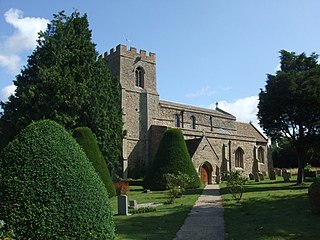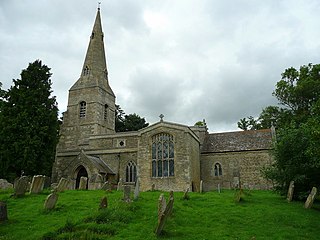
Perry is a village and civil parish in Cambridgeshire, England, approximately 6 miles (10 km) south-west of Huntingdon. Perry is in Huntingdonshire, a non-metropolitan district of Cambridgeshire and historic county of England. Perry is on the shore of a reservoir, Grafham Water, a few miles from the market town of St Neots.

Abbotsley is a village and civil parish within the Huntingdonshire district of Cambridgeshire, England. It is three miles from St Neots and 14 miles from the county town of Cambridge. At the time of the 2001 census, the resident population was 425 people living in 164 households. increasing to a population of 446 at the 2011 Census.

Yelling is a linear village and civil parish in the Huntingdonshire administrative district of Cambridgeshire, England. The village is about 5 miles (8 km) east of St Neots and 6 miles (10 km) south of Huntingdon.

Little Paxton in Cambridgeshire, England is a village and civil parish that lies 5 miles (8.0 km) south of Huntingdon and 1.7 miles (2.7 km) north of St Neots. It is in the district and historic county of Huntingdonshire. Until the 1970s it was a minor village and the church was under threat of closure. The building of a housing estate and a junior school revived its fortunes and the establishment of the Paxton Pits Nature Reserve around part of the nearby gravel pits has brought visitors to the village.

Great Paxton is a village and civil parish in Cambridgeshire, England. It is in Huntingdonshire which is a non-metropolitan district of Cambridgeshire as well as being a historic county of England. The village lies 2.6 miles (4.2 km) north of St Neots in the Great Ouse river valley.

Winwick is a village and civil parish in Cambridgeshire, England. Winwick lies approximately 10 miles (16 km) north-west of Huntingdon. It is a crossroads village on the B660 near Hamerton. Winwick is situated within Huntingdonshire which is a non-metropolitan district of Cambridgeshire as well as being a historic county of England.

Diddington is a small village and civil parish in Cambridgeshire, England. Diddington lies approximately 5 miles (8 km) south-west of Huntingdon, near to Buckden. Diddington is situated within Huntingdonshire which is a non-metropolitan district of Cambridgeshire as well as being a historic county of England. Its population at the time of the 2011 census was 139.

Fenstanton is a village and civil parish in Cambridgeshire, England, 2 miles (3 km) south of St Ives in Huntingdonshire, a non-metropolitan district of Cambridgeshire and historic county. Fenstanton lies on the south side of the River Ouse.

Tetworth is a village and former civil parish, now in the parish of Waresley-cum-Tetworth, in Cambridgeshire, England. Tetworth lies approximately 12 miles (19 km)south of Huntingdon, near Waresley south of St Neots. Tetworth is situated within Huntingdonshire which is a non-metropolitan district of Cambridgeshire as well as being a historic county of United Kingdom. In 2001 the parish had a population of 45.

Waresley is a village and former civil parish, now in the parish of Waresley-cum-Tetworth, in Cambridgeshire, England. Waresley lies approximately 11 miles (18 km) south of Huntingdon and 5 miles (8 km) south-east of the town of St Neots. Waresley is situated within Huntingdonshire which is a non-metropolitan district of Cambridgeshire as well as being a historic county of England.

Hemingford Abbots is a village and civil parish in Cambridgeshire, England. Hemingford Abbots lies approximately 3 miles (5 km) east of Huntingdon, and is almost continuous with neighbouring Hemingford Grey. Hemingford Abbots is situated within Huntingdonshire which is a non-metropolitan district of Cambridgeshire as well as being a historic county of England.

Tilbrook is a village and civil parish in the Huntingdonshire district of Cambridgeshire, England, approximately 10 miles (16 km) west of Huntingdon and 24 miles (39 km) north-west of Cambridge. Though administered as part of Cambridgeshire, the village historically belonged to Bedfordshire, being situated 12 miles (19 km) north of Bedford. The parish had a population of 256 in 2021.

Glatton is a village and civil parish in Cambridgeshire, England, some 8 miles (13 km) south-west of Peterborough, near the villages of Conington, Yaxley and Stilton. It lies in the non-metropolitan district of Huntingdonshire, which is part of Cambridgeshire as well as being a historic county. A World War II airfield built nearby is now known as Peterborough's Conington Airport.
Great Staughton is a village and civil parish in Cambridgeshire, England. Great Staughton lies approximately 8 miles (13 km) south-west of Huntingdon. Great Staughton is situated within Huntingdonshire which is a non-metropolitan district of Cambridgeshire as well as being a historic county of England.

Hail Weston is a village and civil parish in Cambridgeshire, England. Hail Weston lies approximately 7 miles (11 km) south of Huntingdon. Hail Weston is situated within Huntingdonshire which is a non-metropolitan district of Cambridgeshire as well as being a historic county of England.

Easton is a village and civil parish in Cambridgeshire, England. Easton lies approximately 6 miles (10 km) west of Huntingdon, between the villages of Ellington and Spaldwick. Easton is situated within Huntingdonshire which is a non-metropolitan district of Cambridgeshire as well as being a historic county of England. Easton is a hamlet which the Anglo Saxons settled in.

Offord Cluny is a village and former civil parish, now in the parish of Offord Cluny and Offord D'Arcy. It is 4.9 miles (7.9 km) north of St Neots and 3 miles (4.8 km) south-west of Huntingdon. Offord Cluny is in Huntingdonshire which is a non-metropolitan district of Cambridgeshire as well as a historic county of England. Offord Cluny is the twin village of Offord D'Arcy and together they are known as The Offords. At the time of the 2001 census, the population of Offord Cluny was 502 people. Historically both had their own parish councils but these were merged in 2009. Council tax rates are higher in Offord Cluny than in Offord D'Arcy.

Broughton is a village and civil parish in the Huntingdonshire district of Cambridgeshire, England, around six miles north of Huntingdon. Broughton is situated within Huntingdonshire which is a non-metropolitan district of Cambridgeshire as well as being a historic county of England. According to the UK census of 2001 it had a population of 241, reducing to 237 at the 2011 census.

Southoe is a small village and former civil parish, now in the parish of Southoe and Midloe, in Cambridgeshire, England. Southoe lies approximately 6 miles (10 km) south-west of Huntingdon on the A1. Southoe is situated within Huntingdonshire which is a non-metropolitan district of Cambridgeshire as well as being a historic county of England. In 1931 the parish had a population of 211.

Offord D'Arcy is a village and former civil parish, now in the parish of Offord Cluny and Offord D'Arcy. It is 4.2 miles (6.8 km) north of St Neots and 3 miles (4.8 km) south-west of Huntingdon. Offord D'Arcy is in Huntingdonshire which is a non-metropolitan district of Cambridgeshire as well as a historic county of England. It is the twin village of Offord Cluny and together they are known as The Offords. Historically both villages had their own parish councils but the two civil parishes were merged on 1 April 2010. At the time of the 2001 census, the population of Offord D'Arcy was 747 people.

























